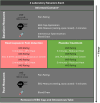Is there a difference between heat-capsaicin induced low back pain and placebo for neural oscillations and inflammatory blood markers? An experimental randomized crossover study
- PMID: 41019709
- PMCID: PMC12460418
- DOI: 10.3389/fpain.2025.1621810
Is there a difference between heat-capsaicin induced low back pain and placebo for neural oscillations and inflammatory blood markers? An experimental randomized crossover study
Abstract
Purpose: Low back pain is difficult to study due to its heterogeneity. Inducing back pain experimentally, with an established model such as heat-capsaicin, would beneficially control for some variability. How heat-capsaicin affects neurophysiological factors relevant to back pain is currently unknown, therefore, this study used a randomized crossover design with the aim to explore the differences between heat-capsaicin and placebo on brain activity and blood markers.
Methods: 18 healthy participants completed two sessions: heat-capsaicin (45°C heat + capsaicin) and placebo (reduced heat + placebo). Pre- and post-pain-induction/placebo, electroencephalogram and blood draws were taken, and perceived pain was rated with a 100 m visual analog scale. Band power was calculated for theta (4-8 Hz), alpha (8-13 Hz), beta (13-30 Hz), gamma1 (30-58 Hz), and gamma2 (62-100 Hz) for six brain regions. An immune assay was run on plasma in duplicate for cytokines IL-1β, IL-6, IL-10, and TNFα. A repeated measures ANCOVA was run for all variables comparing between conditions (heat-capsaicin, placebo) with baseline measures as covariates. A Pearson's correlation was used to determine the relationship between perceived pain ratings and brain wave and blood biomarkers.
Results: The heat-capsaicin model induced transient mild to moderate pain which was significantly higher than placebo (24.50 vs. 0.39; p < 0.001). Brain wave and blood biomarkers were not significantly different between heat-capsaicin and placebo (p ≥ 0.05) or correlated to perceived pain ratings (p ≥ 0.15).
Conclusion: Levels of perceived pain did not relate to neurophysiological changes that may occur immediately after heat-capsaicin exposure. Although changes have been found with other pain models and clinical low back pain, a statistically significant systematic response was not measurable using blood cytokine markers immediately after pain induction and may take longer to develop.
Keywords: EEG band power; brainwaves; cytokines; electroencephaloagraphy (EEG); experimental low back pain; heat-capsaicin; placebo.
© 2025 Frey, Summers, Power, Duarte and De Carvalho.
Conflict of interest statement
The authors declare that the research was conducted in the absence of any commercial or financial relationships that could be construed as a potential conflict of interest.
Figures





References
-
- Ferreira ML, de Luca K, Haile LM, Steinmetz JD, Culbreth GT, Cross M, et al. Global, regional, and national burden of low back pain, 1990–2020, its attributable risk factors, and projections to 2050: a systematic analysis of the global burden of disease study 2021. Lancet Rheumatol. (2023) 5(6):e316–29. 10.1016/S2665-9913(23)00098-X - DOI - PMC - PubMed
LinkOut - more resources
Full Text Sources

